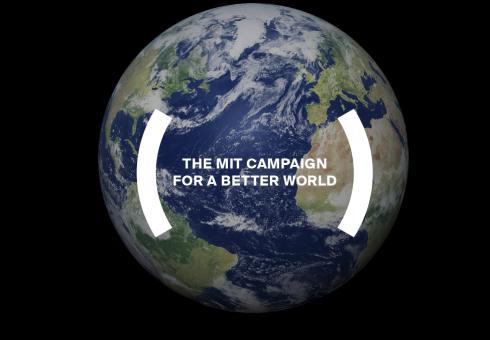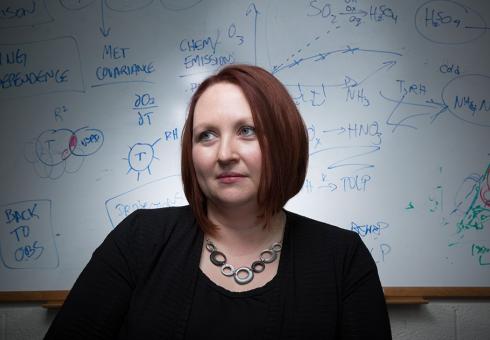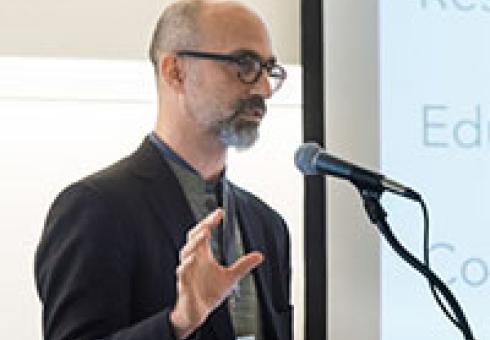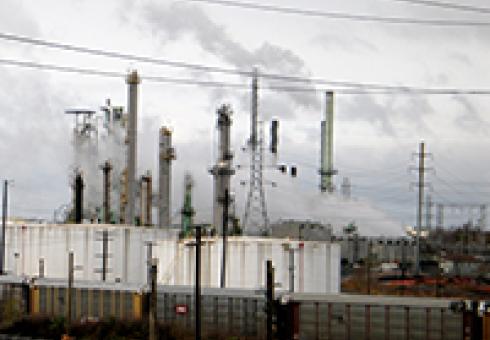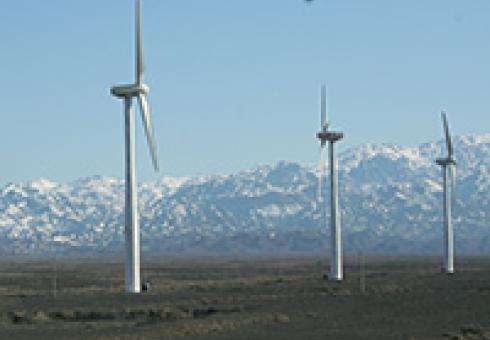CS3 In the News
Led by World Bank and IMF, coalition seeks to price emissions to tackle climate change
MIT has formally joined the Carbon Pricing Leadership Coalition, a global partnership of governments, businesses, and civil society organizations working together with the goal of applying a price on carbon emissions, the predominant cause of climate change.
The energy giant signals a change in its thinking
Royal Dutch Shell is creating a new unit specially for renewables and alternative energy, but it continues to insist that its current business of burning hydrocarbons is under no threat from global policies to mitigate climate change.
Grad student Jesse Jenkins and professor Valerie Karplus discuss challenges of emissions pricing in a new paper
In a new working paper titled "Carbon pricing under binding political constraints," MIT Institute for Data, Systems and Society doctoral candidate Jesse Jenkins and Sloan School of Management Assistant Professor Valerie Karplus discuss the political obstacles facing efforts to price carbon emissions and outline a set of starting points that are both politically palatable and steps toward effective policies to curb climate change.
Comprehensive fundraising initiative aims to raise $5 billion to advance Institute's work on some of the world's biggest challenges
MIT President L. Rafael Reif today announced the official launch of the MIT Campaign for a Better World, a comprehensive fundraising initiative that will amplify the Institute's distinctive strength in education, research, and innovation, and will advance MIT’s work on some of the world's biggest challenges.
MIT has a history of discovery, knowledge creation, and innovation. Through the MIT Campaign for a Better World, MIT aims to extend that track record, raising $5 billion in support of efforts that, as announced by Reif, will enable a future where fundamental science unlocks new knowledge; where climate change yields to climate action; where clean energy is universal; where everyone can count on clean water and nourishing food; where we detect disease before it has symptoms; where Alzheimer's itself is just a memory; where good ideas don’t languish in the lab but flourish in the marketplace; where daring companies create thriving industries and achieve lasting progress; where prosperity is measured not in dollars alone but in the currency of art, culture, and understanding; where quality education is radically more available; and where we offer the world's undiscovered talent a digital path to a creative future.
To ensure that MIT continues to attract a community of exceptionally talented students and faculty, and provides the infrastructure their pioneering work demands, the Campaign is also committed to strengthening the Institute's core — increasing resources for undergraduate financial aid, graduate fellowships, and professorships; reimagining residential living and educational spaces; and developing innovative research facilities such as MIT.nano.
"Humanity faces urgent challenges — challenges whose solutions depend on marrying advanced technical and scientific capabilities with a deep understanding of the world's political, cultural, and economic complexities," Reif said.
"We launch the Campaign for a Better World to rise to those challenges and accelerate positive change. In this effort, we seek the support of enthusiastic partners who share our sense of mission and infinite possibility — including our remarkable alumni, who do the great work of MIT in the world every day," he continued. "Together, through this Campaign, we will give the brilliant minds and hands of the MIT community the fuel and the focus to make inspiring progress for the world."
The Campaign is guided by six priority areas that span the full breadth of MIT:
- Discovery Science: Transforming our world through fundamental scientific research
- Health of the Planet: Addressing critical environmental and sustainability challenges facing humankind through science, technology, design, management, and policy
- Human Health: Defining the future of health through advances in basic science and engineering — informed by expertise in disciplines such as management, economics, and political science
- Innovation and Entrepreneurship: Accelerating the path from idea to impact
- Teaching, Learning, and Living: Reimagining education for the 21st-century learner
- The MIT Core: Attracting extraordinary students and faculty, and providing them with the resources they need to thrive
"The MIT Campaign for a Better World represents an important and historic undertaking," said Julie A. Lucas, MIT's vice president for resource development. "Its priorities transcend disciplines and reflect the breadth and depth of the Institute's commitment to bringing real change to the world. This is an extraordinary moment in the life of MIT."
As of the end of the first quarter of 2016, MIT has raised over $2.6 billion toward the Campaign goal, with gifts coming from more than 77,000 alumni and friends. The Institute's most recent comprehensive fundraising campaign ran from 1997 to 2004.
"This Campaign will have far-reaching positive implications for the world at large," said Robert B. Millard '73, chair of the MIT Corporation. "It is an opportunity to re-inspire, reenergize, and recommit the MIT community to our shared vision and values, while amplifying the power of our students, faculty, and staff to shape the future by providing them with the resources they need to do their best work.”
For more information on the MIT Campaign for a Better World, visit betterworld.mit.edu and follow #MITBetterWorld.
Joint Program research highlighted in the MIT Campaign for a Better World:
https://betterworld.mit.edu/better-climate-predictions-more-resilient-agriculture/
https://betterworld.mit.edu/the-nature-of-hurricanes/
https://betterworld.mit.edu/true-costs-energy-policy/
https://betterworld.mit.edu/the-oceanclimate-connection/
http://mitsloan.mit.edu/campaign/mit-sloan-campaign-priorities/health-of-the-planet/
Although the Paris agreement scheduled to be signed 22 April aims for a 2°C warming cap, new findings show that even a 1.5°C rise will hit glaciers hard.
To mark Earth Day, leaders from more than 165 countries are expected to gather at the United Nations tomorrow for a ceremony to sign the Paris climate agreement, reached last December. Under the historic deal, each country has set targets to reduce greenhouse gas emissions, with the ultimate goal to keep the rise in global temperatures below 2°C above the preindustrial average.
However, new research suggests that the emissions caps might not be low enough to prevent damaging impacts for parts of the world that are vulnerable to climate change. A study presented today at the 2016 European Geosciences Union (EGU) meeting in Vienna, Austria, shows big differences between a 2°C warmer world and a 1.5°C warmer world.
A 2°C temperature increase by 2100 would mean that all coral reef ecosystems in tropical regions would be at risk of degradation due to coral bleaching. The study, also published today in Earth System Dynamics, shows that tropical regions would be especially hard hit by a 2°C temperature increase. Warm spells would last up to 50% longer, resulting in corn and wheat yields half what they would be under a 1.5°C increase, the researchers found. What’s more, a 2°C temperature increase by 2100 would also mean that all coral reef ecosystems in tropical regions would be at risk of degradation due to coral bleaching, according to the study led by Carl Schleussner of Climate Analytics in Germany.
Greater Reductions Needed
To limit temperature increases to just 1.5°C, countries may need to strengthen their emission reduction pledges significantly. Even if the current Paris commitments are met and extended beyond 2030, global temperatures are on track to rise 3°C above the preindustrial average, said Massachusetts Institute of Technology climate scientist Erwan Monier.
He collaborated in another study, also presented at the EGU meeting this week, that combined a human activity model with a climate model to look at five different global warming scenarios through 2100. His team found that there is only a 5% probability that the Paris agreement will keep global temperatures below 2°C, even with the most optimistic outlook.
Nonetheless, Monier told Eos that it is still possible to limit temperatures to 2°C by the end of the century. However, that would require major changes in policy. “We’re not on that path right now, but it’s totally achievable,” he said. “I think most people know some policy tools that would get us there, like a carbon tax. But there’s unwillingness to actually use those.”
Possible 2.7°C Rise Scrutinized
Other researchers have focused on tipping points for severe climate impacts that may lie beyond 2°C. Climate scientist Robert DeConto of the University of Massachusetts Amherst published a paper in Nature last month that found that the Antarctic ice sheet would barely contribute to sea level rise if the average global temperature rise stayed below 2°C. Since writing that paper, DeConto has applied his same model to a temperature increase of 2.7°C. At a press conference at the EGU meeting today, DeConto explained that his preliminary results suggest that the Antarctic ice sheet would contribute about 80 centimeters of potential sea level rise in a 2.7°C warmer world. DeConto chose to scrutinize the effects of a 2.7°C increase because the Climate Action Tracker had warned ahead of the Paris agreement that the world is headed for that level of warming by 2100 even if governments fully implement their climate action pledges.
Glacier Loss Will Continue Under Cuts
Even a modest 1.5°C increase would still result in about half of glaciers melting. Another study finds that regardless of the success of the Paris agreement, some damaging aspects of climate change can’t be stopped. Glacier melt will continue to accelerate, explained Ben Marzeion, a climate scientist at the University of Bremen in Germany. He presented his results during an earlier session at the EGU meeting. If it were scientifically possible for global warming to stop today, glaciers would still lose 30% of their mass. Even a modest 1.5°C increase, according to Marzeion, would still result in about half of glaciers melting.
—Megan Gannon, Freelance Writer; email: megan.i.gannon@gmail.com
© 2016. The authors. CC BY-NC-ND 3.0
Photo: Men and children withdrawing water for irrigation in the Dogon plateau (Mali) during a sandstorm day. New research finds that warm spells in tropical regions will likely last 50% longer if warming exceeds the global preindustrial average temperature by 2°C rather than by 1.5°C. (Credit: Velio Coviello via imaggeo.egu.eu, CC BY-SA 3.0)
Colette Heald studies atmospheric gases and particles, and how they affect air quality and climate
Winds that blow across the Sahara desert in North Africa pick up particles of soil and sand, and typically carry them westward. Many of these grains travel across the Atlantic, leading to poor-visibility days in the southern U.S. and Caribbean, transporting nutrients to far-flung ecosystems in South America, and impacting hurricane formation in the Atlantic.
That’s just one example of the myriad ways that the behavior of tiny particles blown by the wind can have large-scale local, regional, and even global effects on the complex systems that govern Earth’s atmosphere. For Colette Heald, trying to unravel the intricate patterns of the atmosphere’s composition and chemistry, and the way these affect ecosystems, air quality, and even the climate itself, has been the driving force of her career.
Heald, who earned tenure at MIT last year, is the Mitsui Career Development Associate Professor in the Department of Civil and Environmental Engineering and also holds an appointment in the Department of Earth, Atmospheric and Planetary Sciences. Originally from Canada, she was born in Montreal and grew up in Ottawa, where her father was a paper industry executive and her mother a nurse. An older sister, who still lives in Canada, is an aerospace engineer.
Heald earned her BS in engineering physics at Queen’s University in Kingston, Ontario, and while there started doing summer research projects with faculty members at the University of Toronto. That’s when she got introduced to the field of atmospheric science. “I was so excited,” she says, to discover the deep connections between the kind of technical engineering research she had studied and the global environment. That led her to pursue a doctorate in atmospheric chemistry at Harvard University.
Coming from all directions
“That seemed like a flip from physics,” she recalls, “and I was concerned that I didn’t have the chemistry background for it.” But she soon discovered that the field “is so interdisciplinary; people come from a variety of directions” and bring different perspectives to the research.
She immediately became fascinated by the use of satellite data to study the atmosphere and its interactions. The timing was good: The first satellites measuring atmospheric pollution had been launched just a few years earlier.
One of the things measured by satellites was the concentration of carbon monoxide in the air. That compound “is produced from all kinds of combustion processes, and it’s a nice indicator because it stays in the atmosphere for about a month,” she says, “so we can use it to investigate the transport of plumes from sources to continents down-wind.”
Heald describes her current work as “trying to understand the sources, transformation, and impact of gases and particles in the atmosphere, which is very dynamic with a lot of chemical compounds that interact.” In a sense, she says, her focus is on figuring out what’s missing — where the holes are in models of the atmosphere, and how to fill those gaps. “I take an endpoint perspective,” she says. “I integrate the knowledge we have, and look for new ways to analyze the data to see what’s missing in our models.”
The effects are often subtle and hard to tease out from the chaotic mix of atmospheric processes. For example, in summer months the plumes of dust that constantly waft away from the Sahara desert end up in the North Atlantic and can make landfall in the United States and contribute to poor air quality in Florida. In the winter months winds blow the dust, which bears a complex load of assorted minerals, across to South America.
Trans-Atlantic fertilizer
One of those minerals is phosphorus, which happens to be a key limiting element for the growth of plants in the Amazon basin — so those African breezes are actually contributing to the Amazon’s fertility. That’s the kind of complex interaction, she explains, that would never be derived solely from theoretical modeling or experimental observation but requires the integration of different disciplines and approaches. “That gives you a sense of the challenge,” she says.
“There needs to be a strong coupling between observational work and modeling,” Heald says, “and these are models that take decades of development and a large community of scientists.” Much of her research focuses on aerosols, particles of matter so small that they virtually defy gravity and can stay aloft for weeks. Another major area of her research is the complex interaction between the atmosphere and the biosphere.
One thing that makes the modeling difficult is that many of the important processes in atmospheric chemistry involve transport across ocean basins, and “there are not a lot of observations available” over vast stretches of ocean. For example, for dust “we have long-term records in Barbados and in Florida, but we have to connect the dots” to extrapolate to the missing areas. Satellite data are helping to fill in the blanks, but careful calibration is required to make sure these measurements dovetail with the ground-based records.
Heald’s modeling work has showed, for example, that in recent decades winds have been slowing over Africa, and that could reduce the flow of those aerosols to the Americas. Since those particles have an overall cooling effect, by radiating back incoming sunlight, their reduction leads to an overall warming, she explains.
Heald says she has always been interested in many different subjects and had a hard time initially in college deciding what she wanted to major in, even considering art history. “My sister told me, you’ll always be able to experience art and literature, but it’s hard to pursue science and engineering as a hobby!”
While acknowledging that many women have experienced discrimination in their scientific education and careers, “I feel very fortunate,” Heald says, about the support and encouragement she received throughout her education and early career. “I was never discouraged, always only encouraged. I never felt that any doors were closed to me.”
The community of atmospheric chemists, she says, “is very collegial, and I’m grateful for the smooth path I’ve had and the friendly collaborations I’ve developed along the way. I know not all fields are like that, so when I have a chance to help or give back, I try to get involved.”
Photo: Colette Heald describes her current work as “trying to understand the sources, transformation, and impact of gases and particles in the atmosphere, which is very dynamic with a lot of chemical compounds that interact.” (Photo by Bryce Vickmark)
Progress report underscores strong collaboration across campus to address climate change
Vice President for Research Maria Zuber today released a report outlining progress in several key areas of MIT’s five-year Plan for Action on Climate Change, underscoring strong collaboration across campus in addressing what the report calls “the urgent problem of global climate change.”
The Institute first announced the multifaceted plan last October, presenting steps MIT will take to fight global climate change. The five-year plan will enhance efforts in five key areas of climate action, now called the “five pillars”:
- improving understanding of climate change and advancing novel, targeted mitigation and adaptation solutions;
- accelerating progress toward low- and zero-carbon energy technologies;
- educating a new generation of climate, energy, and environmental innovators;
- sharing knowledge about climate change, and learning from others around the world; and
- using the MIT community as a “test bed” for change.
Today’s report provides updates on new and continuing initiatives that directly support those five pillars, including research grants, MIT’s Environmental Solutions Initiative (ESI), low-carbon energy centers, energy-industry partnerships, academic conferences and contests focused on climate-change solutions, and tools to improve energy efficiency on campus.
The report also highlights a new Climate Action Advisory Committee (CAAC), methods for engaging external partners, and ways to communicate the plan’s progress, including through a website and annual report.
“As we said in our climate action plan, our goal is for MIT to seize a position of leadership in the urgent fight against climate change,” Zuber says. “Thanks to the talents and energy of people across the MIT community, we are making steady progress in activating our plan. Seeing the gathering of world leaders in New York on Earth Day to begin to put the Paris Agreement into effect gives us reason for optimism — and reminds us that we have a lot of work ahead of us.”
Assembling the CAAC
Zuber is now finalizing membership of the CAAC, first announced in March in an agreement reached between MIT and the student-led group Fossil Free MIT. The CAAC, headed by Zuber, aims “to bring to bear on climate action the full depth and breadth of the MIT community’s talent, experience, expertise, and creativity,” the report says.
According to the report, CAAC membership will include: one director or representative each from the ESI, the MIT Energy Initiative (MITEI), the Center for Global Change Science, the Center for Energy and Environmental Policy Research, the Climate CoLab, the Joint Program on the Science and Policy of Global Change, the MIT Office of Sustainability, the Sloan Sustainability Initiative; two undergraduates, two graduate students, two postdocs, and two alumni; one additional faculty member; two additional staff members; and any interested MIT Corporation members.
The primary responsibilities of the CAAC are to: consult on the implementation of the plan; develop a set of strategies and benchmarks for MIT’s engagement with industry, government, and other institutions; and assist in finding ways to engage the broader MIT community in climate action. Plans are for the first CAAC meeting to take place in early May.
Building the five pillars
The report provides updates to many MIT initiatives that now support the plan’s five pillars.
Toward the goal of understanding of climate change and advancing mitigation and adaptation solutions, the ESI will announce a second round of environmental-solution seed grants in fall 2016. (Seed grants were also awarded last year.) In keeping with the ESI’s five-school approach, seed grants will support faculty partnerships across multiple departments to pursue critical climate and environmental research questions.
Additionally, at an Earth Day event held on campus on April 22, ESI Director John Fernandez detailed his vision for the ESI’s three key areas of focus: research, education, and convening. Primary research topics include climate science and earth systems, cities and infrastructure, and sustainable society and economy. Education initiatives will include new problem sets, lectures, and modules focused on environmental issues in required undergraduate classes, and the formation of a student “corps” for environmental action. Convening means more collaborative events across campus, such as the Hackathon for Climate, organized in January by the ESI and Climate CoLab.
“We’re at an inflection point [for climate action], both globally and institutionally,” Fernandez says. Globally, the Paris climate agreement succeeded in rallying world leaders around reducing greenhouse gas emissions. At MIT, he said, “an environmental initiative is 30 years in the making. We’re really at a point where all the planets are aligning and, from upper administration to Fossil Free MIT, the community is really engaged in ways that we can really do something substantial.”
To help accelerate progress toward large-scale deployment of low- and zero-carbon energy technologies, MITEI has been setting up its eight new Low-Carbon Energy Centers (LCECs), each focused on advancing a specific technology area key to addressing climate change; it has named two co-directors for four of the centers, with others to follow. In February, national energy provider Exelon announced plans to join several LCECs.
Last November, MITEI’s Utility of the Future Study workshop brought together faculty from MIT and the Institute for Research in Technology in Madrid, along with leaders from 20 energy companies, and members of government energy bodies, to examine alternative business models and technologies in the power sector. In May, MITEI hosts the final workshop to prepare for the study’s conclusion and report release this fall. One of the LCECs, the Center for Electric Power Systems, will launch as the study concludes, leveraging the study’s findings for further research. MITEI is also launching the Mobility of the Future Study this spring to explore ways to decarbonize the transportation sector.
“As MITEI is developing the eight Low-Carbon Energy Centers, it’s a great time to both reflect on and build on the wealth of energy research across the Institute dedicated to advancing technologies that can help address climate change,” MITEI Director Robert Armstrong says. “Our team is enjoying working with such innovative faculty members and students to shape these centers, and we’re simultaneously having many productive conversations with industry and government representatives interested in getting involved in this collaborative research initiative.”
As part of the third pillar, educating a new generation of climate, energy, and environmental innovators, ESI is working with faculty and students to design a minor in environment and sustainability. It will include four main components: earth system and climate science, environmental governance, engineering for sustainability, and environmental history and culture.
To help share knowledge about climate change, the Climate CoLab last October launched a contest soliciting ideas on how MIT alumni can help implement the plan. Winners are being selected now, and may present their proposals at MIT and beyond. Earlier this year, the Climate CoLab launched 13 open contests calling for expert strategies in addressing climate change in many areas, including decarbonizing energy supply, shifting public attitudes and behaviors, infrastructure, waste management, and information technologies.
Furthering the fifth pillar, using the MIT community as a “test bed” for change, Zuber and Fossil Free MIT recently underscored that a 32 percent reduction in carbon emissions on campus is the minimum; the campus will strive to be carbon neutral. In January, the Office of Sustainability released MIT’s first comprehensive greenhouse gas inventory. The Office of Sustainability will report findings of the Energy and Greenhouse Gas Working Group, tasked with finding ways to reach 32 percent emissions reduction and beyond.
In March, the Office of Sustainability and Climate CoLab launched a contest for ideas from MIT and outside to reduce emissions on the MIT campus. MIT has finalized a gas supply agreement with Eversource for the campus cogeneration plant to run entirely on natural gas by 2020, with the exception of emergencies and testing. The Department of Facilities has adopted Leadership in Energy and Environmental Design (LEED) Gold version 4 as the standard for all new construction and major renovations; the department is also assessing any roof’s suitability for solar panels. A Sustainability Data Hub, an open data platform for campus energy use, is being designed, and the Department of Facilities is finalizing a carbon calculator for MIT capital projects. In November, Zuber announced MIT will soon enact “shadow” — or “internal” — carbon pricing at MIT.
Office of Sustainability Director Julie Newman heads up many initiatives of the fifth pillar, which she calls an “ambitious” undertaking. But, she says, the MIT community has quickly rallied around the idea of considering carbon reduction in all new campus projects. “Carbon reduction is not a second thought anymore,” she says. “It’s becoming integrated into the decision process. I don’t think I’ve seen a campus move so quickly to incorporate changes.”
Sustained engagement
The report stresses the need for more sustained engagement with governments, industries, and other institutions of higher education in combating climate change. “While this strategy of engagement is reflected clearly in the plan’s action items, it must go beyond these to fully leverage MIT’s convening power,” the report says.
Potential engagement opportunities include: direct interactions with other stakeholders, facilitated gatherings of industry and other partners in Cambridge and beyond, and town hall-style events with the MIT community.
The upcoming Global Change Forum hosted by the MIT Joint Program on the Science and Policy of Global Change will focus on “Corporate Strategy and Climate Change” to examine how public and private sectors can adapt to climate change. And the Center for Energy and Environmental Policy Research will host a workshop in May for industry participants, academics, and policymakers to examine research on energy and environmental policy.
The report says Zuber also plans to convene a forum in the coming months to explore ethical responsibilities of countries, industries, companies, institutions, and individuals in limiting the increase in average global temperatures to 2 degrees Celsius over preindustrial levels.
Getting the word out
Future updates of the plan will be shared via climateaction.mit.edu, which is being revamped and will relaunch in a few months. On the website, people can find information about specific roles and activities of MIT offices involved in the plan, upcoming climate-related events on campus, and contacting members of the CAAC.
The Office of the Vice President for Research plans to produce an annual report to assess MIT’s progress in implementing the plan and how the plan’s external partners are responding to the climate challenge.
Photo: ESI Director John Fernandez detailed his vision for the ESI at a recent Earth Day event held on campus on April 22 (Photo by Justin Knight)
Cheap oil fuels other parts of the world economy
John Reilly | MarketWatch
The crash in the price of oil — from $108 a barrel in June 2014 to below $27 earlier this year — has rattled the stock market, triggered layoffs across the energy sector, and plunged many oil producing countries into crisis.
Oil has since rebounded significantly from its lows, to above $40 a barrel, but the price plunge since 2014 has put much pressure on oil companies. Reports have pointed to an increase in debt among oil producers, raising the specter of default on bankruptcy and default on debt, with follow-on effects beyond oil producers.
The upheaval also has sparked fears that oil’s troubles will spread across the globe, echoing the crash in U.S. housing markets that pushed the world economy to the brink of collapse in 2008. Yet despite the woes oil is experiencing, it is unlikely that the repercussions will trigger another global financial crisis.
Looking at the numbers, the mortgage-debt crisis dwarfs what is currently happening in oil. According to a report in the Financial Times, the global oil and gas industry’s debts rose to $3 trillion from $1.1 trillion between 2006 and 2014. Compare that to the $10 trillion of housing debt weighing on Americans in 2008.
Aside from the numbers, the impact will be different because of the nature of the oil industry and the role oil plays in the world economy. Boom and bust have been features of the oil business for many years. Companies that have been around for a while understand this, and have learned to adapt. Responding to earlier crises, they made significant cuts and improved efficiency. Because they run lean operations, these companies are better prepared to weather downturns. Also, the major players in the oil industry are not highly leveraged, and thus we have not seen anything like the cascade of failures among lenders and suppliers that made the housing bust so damaging.
It is also important to note that the marginal cost of extracting oil from the ground is relatively low once the initial cost of developing a field is sunk. Even if prices are low, companies can continue to make money. It won’t be as much as they would make in good times, but the businesses can still generate revenue and profits. When oil companies cut back, they halt or delay investments in new fields, but their existing wells continue to produce.
Although some smaller or newer oil companies have been forced out of business by the price collapse, the larger, established players are unlikely candidates for bankruptcy. What tends to happen in the oil business is consolidation, which has been a feature of the industry for nearly two decades: look at Exxon XOM, +0.71% and Mobil; Chevron CVX, +0.39% and Texaco; BP BP, -1.46% and Amoco, and other mergers that occurred in the 1990s and early 2000s — another time when oil prices were extremely low.
That round of mergers and acquisitions reduced the number of companies considerably, and so room for further consolidation may be limited. Also, many of the remaining companies are state-owned or state-controlled and thus not candidates for acquisition or merger unless governments that owned them decided to privatize the assets — an unlikely scenario. But smaller operators with potentially valuable mineral rights will become candidates for acquisition by cash-rich larger companies.
When weighing the fallout from the oil price collapse, it is important to remember that whatever direction oil prices move, there will be winners and losers. While today the oil industry struggles, other industries, including transportation and manufacturing, are enjoying the benefits of low-cost oil. The fortunes of regions also rise and fall with the price of oil. When the price is high, Texas booms and New England struggles. Falling prices bring the reverse.
Perhaps the most serious consequence of today’s cheap oil is the damage done to governments that rely heavily on tax revenue from oil production. Many of the big oil-producing countries depend heavily on oil revenue to deliver basic services. With the collapse in prices, governments have to cut support for everything from medical care to housing to road repair. Tight budgets, in turn, can fuel political unrest, which may destabilize governments.
The damage to governments is easy to see in Venezuela, Nigeria, and Russia. But it also is apparent in wealthy countries such as Saudi Arabia, which has had to trim its domestic budget and pull back on investment outside of the country. Foreign nationals who traditionally have made up a large part of the Saudi work force may find less opportunity there, which creates a spillover effect in their home countries.
But for most of the world, assessing the effects of the oil price collapse is a process of calculating the many pluses and minuses. Oil industry workers may have much lighter paychecks these days, but consumers have a bit more in their wallets after filling the gas tank.
John Reilly is a senior lecturer at the MIT Sloan School of Management and co-director of the MIT Joint Program on the Science and Policy of Global Change, Center for Energy and Environmental Policy Research.
Photo: Detroit oil refinery (Photo courtesy of Grangernite)
Valerie Karplus, Sloan School of Management
Andrea Carter | Poets and Quants
Valerie Karplus
Assistant Professor, Global Economics and Management
MIT, Sloan School of Management
Forecasts suggest that rapidly developing nations such as China will be responsible for most of the growth in greenhouse gas emissions over the next 50 years. Valerie Karplus isn’t sitting back waiting for it to happen. Instead, she’s doing something about it now and using her expertise on China’s energy system – including technology and business model innovation, energy system governance, and the management of air pollution and climate change – to help correct the course we’re on. From 2011 to 2015, she directed the MIT-Tsinghua China Energy and Climate Project, a five-year research effort that focused on analyzing the design of energy and climate change policy in China, along with its domestic and global impacts.
Alongside her research, Professor Karplas teaches Entrepreneurship Without Borders and New Models for Global Business, along with co-developing an all new course at MIT on Global Energy Markets and Policy. She also serves the university as a faculty affiliate of the MIT Joint Program on the Science and Policy of Global Change and the MIT Energy Initiative.
Age: 35
At current institution since: 2006
Education: B.S. Molecular Biophysics and Biochemistry and Political Science, Yale University, 2002; M.S. Technology and Policy / Civil and Environmental Engineering, Massachusetts Institute of Technology, 2008; Ph.D. Engineering Systems, Massachusetts Institute of Technology, 2011
Courses you currently teach: New Models for Global Business, Entrepreneurship without Borders, Mentor for Global Entrepreneurship Lab, China Lab, and Global Organizations Lab
Professor you most admire: Elinor Ostrom
“I knew I wanted to be a b-school professor when…I discovered I could apply my diverse interests in the management of technology and innovation, the natural sciences and engineering, and global affairs and policy to advance solutions to major challenges facing society—a hallmark of scholarship at MIT.”
“If I weren’t a b-school professor…I would spend my days painting and writing novels.”
Most memorable moment in the classroom or in general as a professor: Leading the CEOs of the MIT Sloan Global Entrepreneurship Lab companies in the Marshmallow Challenge (a game that requires building a structure out of tape, string, and pasta, then placing the marshmallow on top within 18 minutes)—this exercise led to an abundance of creative designs and unexpected insights.
What professional achievement are you most proud of? Building a cross-border, multi-disciplinary research team involving energy economics researchers at MIT and Tsinghua University. Our team contributed to analysis that supported U.S.-China cooperation on climate change ahead of the 2014 Asia-Pacific Economic Cooperation Summit, where Presidents Obama and Xi jointly announced their intended pledges for climate action ahead of the Paris Climate Talks.
What do you enjoy most about being a business school professor? I thoroughly enjoy the variety of topics and challenges I am able to tackle as a business school professor. I also enjoy experimenting with a variety of interactive classroom formats, including simulations, business cases, and debates.
What do you enjoy least about being a business school professor? The fact that a day only has 24 hours—I could easily fill twice that much time with all of the exciting opportu
Fun fact about yourself: When I was young I used to draw cartoons everywhere.
Favorite book: The Giver
Favorite movie: The King’s Speech
Favorite type of music: Classical
Favorite television show: Top Gear
Favorite vacation spot: Big Sur, California
What are your hobbies? Skiing, Painting, Running, Yoga
Website: vkarplus.com
“If I had my way, the business school of the future would have…even closer integration between the classroom and practice. It would also serve jianbing (a Chinese fried-egg pancake often eaten for breakfast) in the canteen.”
Students Say…
“Prof Valerie Karplus, who served as my mentor, is highly approachable and supportive. She always inspires us to approach problems from different perspectives, and with an eye for detail. She teaches us how to think rather than what to think.”
Yuting Fang, MIT Sloan Master of Finance Program, Class of 2016
“At MIT Sloan, students typically have significant industry experience in addition to the required academic background. Accordingly, each student brings with them domain-specific knowledge from a variety of different disciplines, the benefit of having been exposed to a wide range of teaching styles, and varied life experiences. Given this diversity, finding ways to effectively reach all students is a challenge – Professor Karplus continually rose to the challenge. She made a concerted effort to connect the class to the subject matter using her insight, inclusive teaching style and current case studies, thus making the class concepts both meaningful and relevant. She also excelled at connecting us with our fellow classmates. I found her to be an extremely effective educator.”
Dave Whyte, MIT Sloan Ph.D.; currently Head of Cyber Security, Bank for International Settlements
“Professor Valerie Karplus is truly the guru of international strategy. Her classroom is always filled with the most dynamic and interesting discussions (and sometimes debates) of international strategy and culture. Drawing from examples as diverse as Xiaomi, CEMEX and Uniqlo, Professor Karplus helps students build the necessary frameworks to better analyze and think through different internationalization strategies. She challenges students to not only determine HOW companies should go global, but also answer the question of IF companies should go global at all. Professor Karplus is one of the most engaging and thoughtful professors, and her class – New Models for Global Business should be on the shortlist of must take classes.”
Jake Chen, MIT Sloan MBA Class of 2016
DON’T MISS: THE COMPLETE LIST: POETS&QUANTS’ 2016 MOST OUTSTANDING B-SCHOOL PROFS UNDER 40
Photo: Valerie Karplus
Here's how to read the tea leaves
The latest numbers show China is using more coal and energy than previously thought, but the last two years of data suggest China’s coal use may be peaking earlier than expected.
Study finds high risk of severe water stress in Asia by 2050
World's top CO2 emitter on track to reach key climate goal by 2030
Valerie Karplus | ChinaFAQs
Based on recent economic developments and the newly-released Thirteenth Five-Year Plan, China is well on its way to reaching its climate goal of peak CO2 emissions by 2030.
The Plan charts the overarching course of China’s economic and social development through 2020, and will be translated into plans for provinces and specific sectors like energy in the coming months and years. The national plan, by reflecting the government’s high-level priorities, provides important momentum toward meeting China’s climate change commitments.
In many respects, the Plan hews closely to the goals set out in the country’s previous long-term energy plans and its climate policy commitments for the Paris Agreement. China’s pledge included targets to reach peak CO2 emissions around 2030 (with the intention to peak earlier), by reducing the CO2 intensity of economic activity by 60-65% by 2030 relative to 2005, and raising the share of non-fossil energy in the country’s energy mix to around 20% by 2030.
In crafting the Plan, China’s policymakers have emphasized the role of both the expansion of low-carbon energy and continued improvements in energy efficiency. It suggests that even in the face of slower growth, top policymakers recognize that both strategies are consistent with the country’s latest growth targets.
Moving forward on climate and energy
Generally speaking, the Plan is in step with the country’s National Energy Development Plan, released in 2014, which calls for substantial increases in clean and renewable energy deployment through 2020. While the new Five-Year Plan does not mention targets for installed electricity generation capacity, it reaffirms the country’s existing target to raise the non-fossil share of energy use to 15% by 2020. To achieve this goal, China’s National Energy Administration has stated that China will need a total of 250 gigawatts (GW) of wind power capacity, and 150 GW of solar, which would exceed the targets set in 2014 by 50 gigawatts each. (China is also aiming for 350 GW of hydropower capacity by 2020.) Realizing the full generation potential of wind and solar capacity—and its contribution to the country’s non-fossil target—will require reforms that introduce greater flexibility in dispatch and allow balancing across larger grid areas.
Nuclear and biomass are also slated to expand substantially, by 38-49 GW and 30 GW, respectively (Bloomberg New Energy Finance). Expansion of the country’s natural gas infrastructure is also likely to facilitate increased use, which has not occurred as fast as anticipated through 2015.
Energy efficiency will also be critical, especially realizing efficiencies in the parts of the economy that policy doesn’t easily reach. Indeed, many of the large energy users and emitters have cleaned up substantially in recent years in response to energy efficiency directives and technology upgrades. While there may be little low hanging fruit left in some segments of the economy, finding, reaping, and quantifying the remaining opportunities for energy efficiency improvement will be an important task in the Thirteenth FYP.
The creation of a national carbon trading market—focused on large enterprises in high-emitting sectors—will help to support this transition. Set to launch in 2017, the system will price in a portion of the damages of fossil energy use, encouraging clean energy substitution and innovation over the longer term. Finding ways to expand the coverage of the carbon price to smaller and more distributed emitters offers a promising way to expand cost-effective reductions, while preventing “leakage” of emitting activities from covered to un-covered sectors.
As in past Plans, the Thirteenth FYP lays out energy and CO2 intensity reduction targets. The plan targets an energy intensity reduction of 15% (the Twelfth FYP targeted 16%, while the Eleventh FYP targeted 20%). The targeted CO2 intensity reductions of 18%, compared to 17% for the Twelfth Five-Year Plan, will boost the contribution of low-carbon sources in the energy mix and support further decoupling of China’s economic growth from its reliance on fossil energy. This shift is already well underway—China’s share of coal in primary energy has dropped from over 72% in 2007 to 64% in 2016. The CO2 market will be designed to contribute substantially to sustaining reductions in CO2 intensity, in line with the 18% goal.
A shift toward consumption and services
A shift away from investment and exports toward consumption and services as key economic growth drivers in the coming years now seems to be underway in earnest, and will further contribute to reductions in emissions, relative to a no-shift scenario. In this regard, the government’s objectives are aligned with domestic environmental goals. China’s progress provides lessons for emerging economies generally to help in avoiding an emissions-intensive development path.
All of these developments, while not surprising, are reassuring. Combined with the 6.5%/year average annual growth the Plan targets, the latest energy and CO2 intensity goals could translate into a CO2 emissions peak well before 2030, in keeping with China’s pledge to make best efforts to peak early.
Author Information: Dr. Valerie J. Karplus, a ChinaFAQs expert, is an Assistant Professor in the Global Economics and Management Group at the MIT Sloan School of Management, and is the Faculty Lead of the China Energy and Climate Project in the MIT Joint Program on the Science and Policy of Global Change.
ChinaFAQs is a project facilitated by the World Resources Institute that provides insight into critical questions about Chinese policy and action on energy and climate change. The ChinaFAQs network is comprised of U.S.-based experts, including researchers at U.S. universities and government laboratories, independent scholars, and other professionals.
Photo: Kaj17 via Flickr Creative Commons License




